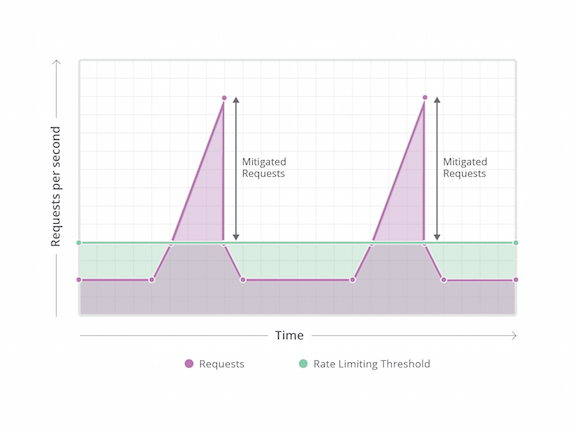Author Archives: John Roberts
Author Archives: John Roberts
Today, we're introducing two new Cloudflare Traffic products to give customers control over how Cloudflare’s edge network handles their traffic, allowing them to shape and direct it for their specific needs.
More than 10 trillion requests flow through Cloudflare every month. More than 4 million customers and 10% of internet requests benefit from our global network. Cloudflare's virtual backbone gives every packet improved performance, security, and reliability.
That's the macro picture.
What's more interesting is keeping each individual customer globally available. While every customer benefits from the network effect of Cloudflare, each customer is (appropriately) focused on their application uptime, security and performance.
Cloudflare’s new Traffic Control allows a customer to rate limit, shape or block traffic based on the number of requests per second per IP, cookie, or authentication token. Traffic can be controlled on a per-URI (with wildcards for greater flexibility) basis giving pinpoint control over a website, application, or API.

Customers seek reliability and availability in the face of popularity or unexpected traffic such as slow brute force attacks on a WordPress site, Denial of Service against dynamic pages, or the stampede of requests that comes with success. We are the leader at stopping significant Continue reading
Two summers ago, with a seemed-big-at-the-time network of 28 datacenters, not long after introducing Medellin, CloudFlare introduced support for WebSockets, initially for our Enterprise customers.
 CC BY 2.0 image by Marcin Wichary
CC BY 2.0 image by Marcin Wichary
Today, with our network nearing 80 global locations, we're pleased to announce support for WebSockets for all our customers, including Enterprise, Business, Pro, and Free, with resources allocated by plan level.
If you don't want to read RFC 6455, then this short paragraph from our previous blog post explains:
The WebSocket protocol is a distinct TCP-based protocol, however, it’s initiated by an HTTP request which is then "upgraded" to create a persistent connection between the browser and the server. A WebSocket connection is bidirectional: the server can send data to the browser without the browser having to explicitly ask for it. This makes things like multiplayer games, chat, and other services that require real-time exchange of information possible over a standard web protocol
There's a lot more technical history in that post covering how we modified NGINX to support a huge number of connections through port reuse. But the bottom line is that WebSockets are a vital technology for web sites that Continue reading

We're big fans of HTTP/2 at CloudFlare. Our customers make up the majority of HTTP/2 enabled domains today. HTTP/2 is a key part of the modern web, and its growth and adoption is changing how websites and applications are built.
On Thursday April 28, 2016, our friends at CatchPoint are hosting a live AMA (Ask Me Anything) with experts from CloudFlare, Akamai, and Google answering questions in real time about the protocol's features, adoption, and future.
When: Thursday April 28, 2016 from 2pm-3pm Eastern Time (1600-1700 UTC)
How: Ask questions ahead of time (and vote on questions). Join in real-time on Thursday.
Who: CloudFlare's own Suzanne Aldrich will join Ilya Grigorik from Google, Tim Kadlec from Akamai, and Andrew Smirnov from Catchpoint.
Need the basics on HTTP/2 ahead of time? Visit the CloudFlare HTTP/2 website.

This week, Google announced that its hosted PageSpeed Service will be shut down. Everyone using the hosted service needs to move their site elsewhere before August 3 2015 to avoid breaking their website.
We're inviting these hosted customers: don't wait...migrate your site to CloudFlare for global acceleration (and more) right now.
 CC BY 2.0 image by Roger
CC BY 2.0 image by Roger
As TechCrunch wrote: "In many ways, PageSpeed Service is similar to what CloudFlare does but without the focus on security."
PageSpeed started as — and continues — as a Google-created software module for the Apache webserver to rewrite webpages to reduce latency and bandwidth, to help make the web faster.
Google introduced their hosted PageSpeed Service in July 2011, to save webmasters the hassle of installing the software module.
It's the hosted service that is being discontinued.
CloudFlare provides similar capabilities to PageSpeed, such as minification, image compression, and asynchronous loading.
Additionally, CloudFlare offers more performance gains through a global network footprint, Railgun for dynamic content acceleration, built-in SPDY support, and more.
PageSpeed Service customers care about performance, and CloudFlare delivers. CloudFlare also includes security, SSL, Continue reading
We’re pleased to introduce a new CloudFlare App: Tinfoil Security. Tinfoil Security is a service designed to find possible web application vulnerabilities.
Security is central to CloudFlare's service. Our security features operate at the network level to identify and block malicious traffic from ever reaching your website or application. However, even with that protection in place, it’s still worth fixing problems at the application layer as well.
Tinfoil Security helps website owners learn about possible vulnerabilities in their applications by scanning for vulnerabilities, tests all access points, and providing step-by-step introductions on eliminating threats if found.

Their developer-focused reports can be tied into continuous integration lifecycle with API hooks for kicking off new scans after changes are made.
Tinfoil offers several price points, including a free plan that checks for XSS (Cross-Site Scripting) concerns. The Tinfoil app is a quick and easy addition to your CloudFlare service. Take a look!